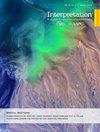Stray gas source determination using forensic geochemical data
IF 1.1
4区 地球科学
Q3 GEOCHEMISTRY & GEOPHYSICS
Interpretation-A Journal of Subsurface Characterization
Pub Date : 2023-05-22
DOI:10.1190/int-2023-0005.1
引用次数: 0
Abstract
There is a standard method for rigorously using geochemical data to identify the source of stray gas. “Stray gas” is defined as gaseous material of undetermined origin found in an area where the gas has impacted the shallow-subsurface, potable water supplies, or has the potential to present a threat to public health and safety. Stray gas is composed of hydrocarbons or other gases, such as CO2. Previous studies have used geochemical data, including molecular and isotopic gas compositions, to empirically constrain the source of stray gas present in samples collected from specific locations (sometimes called “receptors”). On a more granular level than presented previously, we have discussed the interpretive workflow that should be followed to interpret geochemical data in the context of a stray gas investigation. A key concept is that geochemical data should be used impartially to evaluate all potential sources of the stray gas and, where possible, identify the most likely source. Focusing on only a subset of potential gas sources can lead to erroneous conclusions regarding gas sources. Furthermore, to accurately identify the gas source, geochemical data must be interpreted in the context of the site-specific geology, including evidence of previous gas migration events in the area. We illustrate these points using examples from Parker County, Texas, and from Lycoming County, Pennsylvania.利用法医地球化学数据确定杂散气体来源
有一种标准的方法可以严格使用地球化学数据来识别杂散气体的来源。“杂散气体”是指在影响浅层地下饮用水供应或有可能对公众健康和安全构成威胁的地区发现的来源不明的气体物质。杂散气体由碳氢化合物或其他气体组成,如二氧化碳。先前的研究使用了地球化学数据,包括分子和同位素气体成分,来根据经验限制从特定位置收集的样本中存在的杂散气体的来源(有时称为“受体”)。在比之前更细粒度的层面上,我们讨论了在杂散气体调查的背景下解释地球化学数据时应遵循的解释工作流程。一个关键概念是,应公正地使用地球化学数据来评估杂散气体的所有潜在来源,并在可能的情况下确定最可能的来源。只关注潜在气源的一个子集可能会导致关于气源的错误结论。此外,为了准确识别气源,必须在特定地点的地质背景下解释地球化学数据,包括该地区以前发生过气体运移事件的证据。我们使用德克萨斯州帕克县和宾夕法尼亚州利康明县的例子来说明这些观点。
本文章由计算机程序翻译,如有差异,请以英文原文为准。
求助全文
约1分钟内获得全文
求助全文
来源期刊

Interpretation-A Journal of Subsurface Characterization
GEOCHEMISTRY & GEOPHYSICS-
CiteScore
2.50
自引率
8.30%
发文量
126
期刊介绍:
***Jointly published by the American Association of Petroleum Geologists (AAPG) and the Society of Exploration Geophysicists (SEG)***
Interpretation is a new, peer-reviewed journal for advancing the practice of subsurface interpretation.
 求助内容:
求助内容: 应助结果提醒方式:
应助结果提醒方式:


